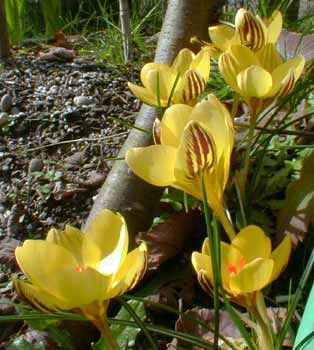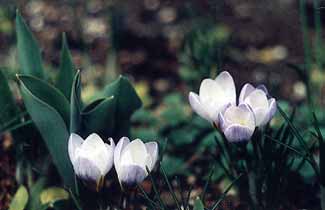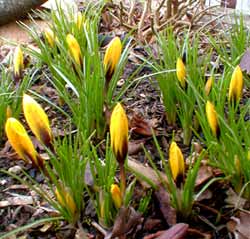 Overview of
Overview of
Late Winter's "Snow Crocuses"
"The daring crocus, unafraid to try
(When Nature calls) the February snows."
-Sydney Lanier,
1880
1880
The four most common species all sometimes called "Snow Crocus" because they bloom so early in the year are C. sieberi native of the Balkins, C. chrysanthus native to Greece & Asia Minor, C. tommasinianus native from Hungary to Bulgaria, & lastly the so-called "Dutch Giant" hybrids, C. vernus of Eastern Europe. C. vernus appears latest on the cusp of spring & because of being greatly hybridized do not naturalize as well as the botanical crocuses, for which reason we have not planted C. vernus, but we have multiple varieties of the other three species, plus more.
In addition to various cultivars of those four most commonly available snow crocus species, we have a few other January/February/March early-bloomers which qualify as snow crocuses. These include C. etruscus 'Zwanenburg' from Corsica, C. korolkowii 'Kiss of Spring' from Central Asia (with fat January buds shown in the third photograph below), & C. ancyrensis 'Golden Bunch' likewise from Central Asia.
 Several long-naturalized & half-wild intermingling drifts of snow crocuses cover a long continuous patch of ground reaching from a 'White Icicle' Flowering Currant to an Oyama magnolia all along a picket fence. As the deciduous currant & magnolia are leafless during the crocus season, they get the sunlight when they need it.
Several long-naturalized & half-wild intermingling drifts of snow crocuses cover a long continuous patch of ground reaching from a 'White Icicle' Flowering Currant to an Oyama magnolia all along a picket fence. As the deciduous currant & magnolia are leafless during the crocus season, they get the sunlight when they need it.The top February photo of the yellow crocus with magenta streaks is C. chyrsanthus 'Gypsy Girl' under the currant. The second photo shows small, round-flowered C. c. 'Blue Pearl' also in February.
Missed in any of these shots, but growing along the same fence line, are C. c. 'Cream Beauty' which is the palest yellow globe-shaped crocus, C. c. 'Prince Claus' which is white with purple blotch on the outer petals, bright yellow C. c. 'Goldilocks,' & white C. c. 'Snow Bunting.' Other species in this vicinity include the March-blooming bright yellow C. x luteus 'Stellaris,' late January & February blooming C. sieberi atticus 'Firefly,' & the largest of the little "tommy" crocuses, C. tommasinianus 'Ruby Giant.' plus other tommies.
 In other of our gardens we have the true wild form of C. tommasinianus plus a named tommy, C. t. 'Whitewell Purple' & the white variant 'Albus.' Elsewhere along path edges are C. siebieri sublimis 'Tricolor,' multi-pastelled C. chrysanthus 'Advance,' & such bright yellows as C. c. var fuscotinctus C. korolkowii 'Mountain's Glory.'
In other of our gardens we have the true wild form of C. tommasinianus plus a named tommy, C. t. 'Whitewell Purple' & the white variant 'Albus.' Elsewhere along path edges are C. siebieri sublimis 'Tricolor,' multi-pastelled C. chrysanthus 'Advance,' & such bright yellows as C. c. var fuscotinctus C. korolkowii 'Mountain's Glory.'Each year we add others here & there, for an ever-increasing collection, as there's just no such thing as too many crocuses. They are so brightly active in the two months before spring perennials are returning in earnest. A few other bulbs also make a late-winter showing, but it is the crocuses that make it seem as though the last half of winter has already turned to spring. In colder climates than ours, the crocus season won't begin so soon as January, but they'll still generally get a jump on spring.
Some people have expressed the opinion that crocuses are too ephemeral in the garden, lasting only two or three weeks, then gone. This has not come close to my experience, as the majority of ours last five or six weeks each. If several cultivars of many species are planted, they will not seem so transient, as there will be overlapping drifts in full flower January through March, without even counting the true autumn bloomers such as C. speciosus, & the earliest winter bloomer C. laevigatus var fontenayi such as further extend the presence of crocuses. So indeed, rather than "too transient in the garden" as some people feel, a good collection will keep the gardens lively with bloom from September to March.
Such a continuous presence is not achievable in all zones, as in colder climates the crocuses erupt later, & in warmer climates they are exhausted much more swiftly. But here on Puget Sound they are long-lasting, with the only criticism being the great percentage of overcast days during which crocuses don't open their petals.